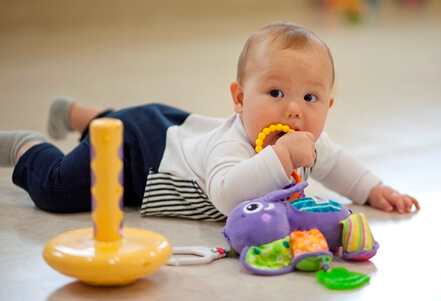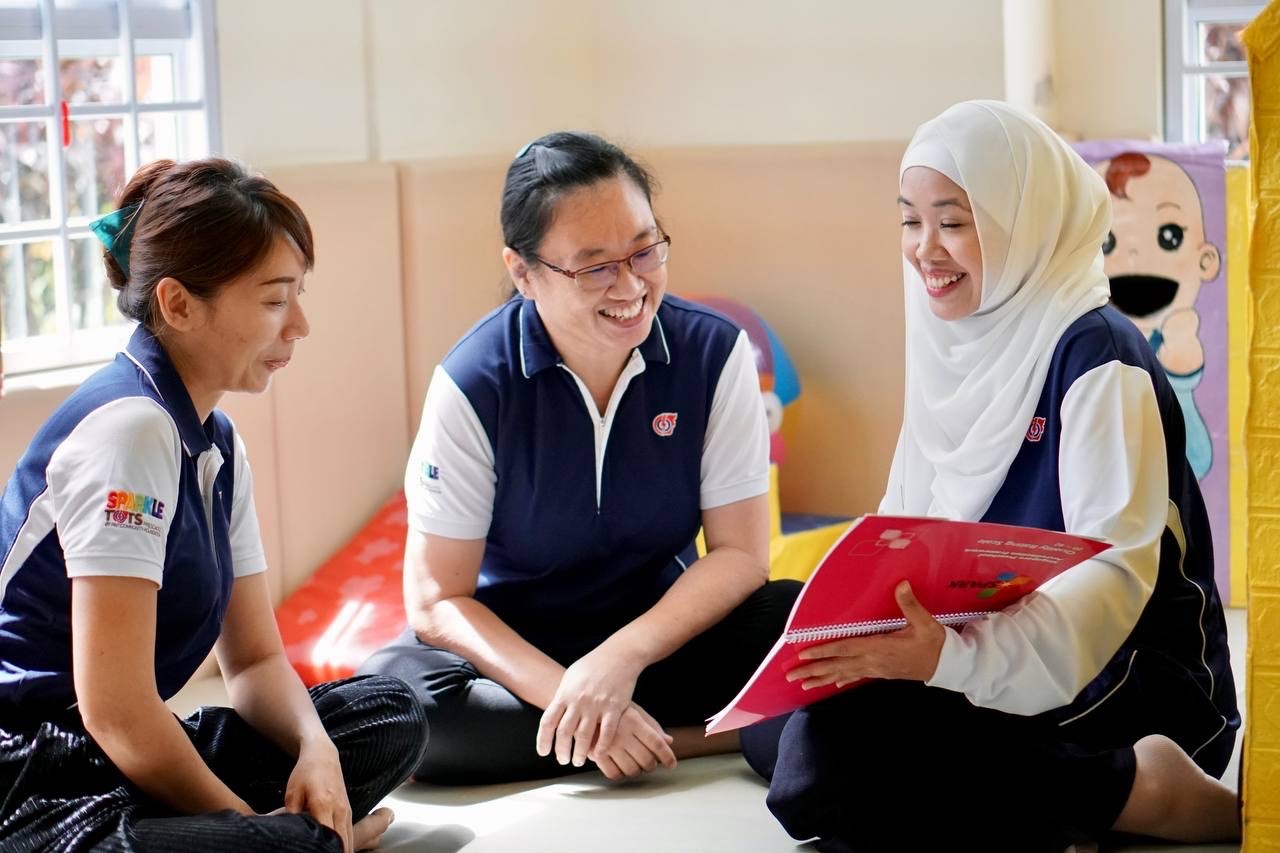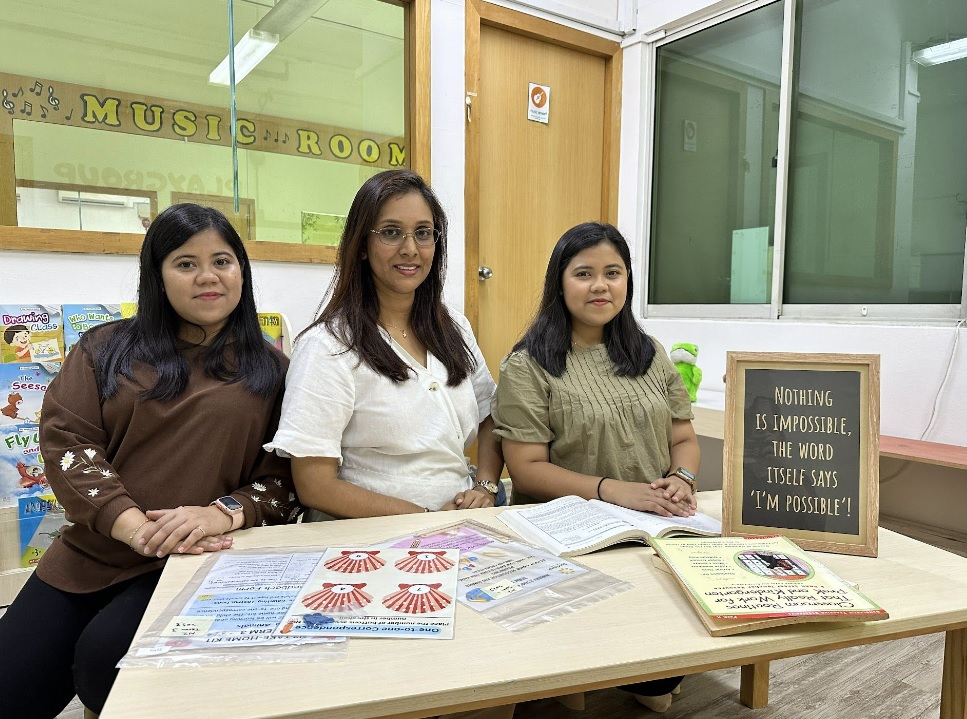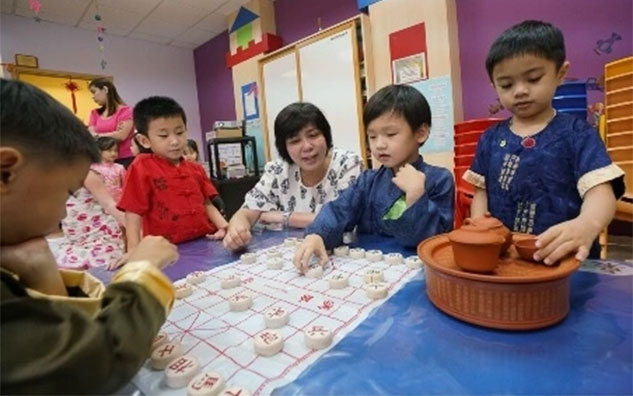 | Learn colours at mealtime.
Let your child participate in a salad making process! Lay your child's food out on a large sheet of aluminum foil in various shapes and patterns. Pick brightly-coloured food items
such as tomato slices, corn, carrots, lettuce leaves and even raisins. Together with your child, put the ingredients together to form a colourful salad! As you add the items in the bowl, talk to her about the colours. These
bright colours will whet your child's appetite! |
| | |
Create fond memories of the zoo!
At your next trip to the zoo, take lots of animal photos. Print out these photos and put together a simple book. Flip through and "read" the book together with your child.
Name the creatures she has seen, describe the physical characteristics, and add animal noises for a more realistic experience! |  |
| | |
Provide opportunities for your child to express himself and get creative.
Place a large-sized paper on the floor. Provide large paint brushes and pots of non-toxic paint for your child to create with. If your
child wants to explore painting with his fingers, encourage him to do so! | 
|
| | |
Paint on ice!
Freeze a large block of ice in a plastic container and place the ice in a tray. Provide your toddler with a giant paintbrush and some watercolours and let her paint away on the melting ice block!
At the end of the activity, press a piece of paper over the ice to make a print of your child's artwork. |  |
| | |
 | Use light and cellophane paper to create a visual art piece!
Shining light through coloured cellophane paper can create beautiful colours in a semi-dark room. Together with your child, layer different coloured cellophane paper over a torch light and watch as the colours change with each
additional layer! Talk to your child about the change in colours! |
| | |
 | Melt ice cubes of coloured water!
Freeze water mixed with different food colouring in ice cube trays. Let the coloured ice cubes melt and see what new colours are formed when the melted cubes mix together!
Use this opportunity to introduce different colours ("Look! Blue and red makes orange") and vocabulary like "cold", "wet". Water can be coloured using food colouring. |
| | |
Have fun with candles and watercolours!
Write simple words or draw simple pictures using candles on paper and let your child paint over with watercolours! Watch their face light up with surprise as the words
or pictures "magically appear" when they paint over the wax with a large paintbrush! | 
|
| | |
Play music, songs, and rhymes in the background.
You can do this when your child is playing or napping to help stimulate thoughts and responses to the tempo, rhythm and beats of the music. This can encourage
mental visualisations of movements or actions for the songs and rhymes.
~ Dr Rebecca Chan, Early Childhood Consultant | 
|
| | |
 | Be available and responsive.
Watch quietly whenever your child engages in the visual arts or music activity and participate in the process only when your child invites you. Otherwise, just be present and available
to your child whenever he looks to you for an acknowledgement (e.g. a nod or smile) or needs assistance. For instance, to open the lid of a paint bottle or changing a music CD when requested.
~ Dr Rebecca Chan, Early Childhood Consultant
|
| | |
 | Have props to encourage creative movement
such as scarves, ribbons, and hula hoops. Ask your child to explore various ways to move the scarves to the music. As there will be no one 'right' answer, it allows him opportunities to succeed. Play different genres
of music and move (tiptoe slowly, running quickly on the spot, stamp around, etc.). Have fun!
~ Ms Lavina Chong, Director/ Co-Founder of Wigglepods Pte Ltd and Associate Professor with SIT-Wheelock College, Singapore |
| | |
 | Sing with your child!
Your child prefers your voice to any music recording! Sing during daily routines such as bath-time, cleaning up, washing hands, etc. Use your own words, preferably action-related words
and sing to the tune of popular nursery songs. Make it an enjoyable and fun experience!
~ Ms Lavina Chong, Director/ Co-Founder of Wigglepods Pte Ltd and Associate Professor with SIT-Wheelock College, Singapore |
| | |
Create Memories.
Take pictures or videos of your child in action. Watch them together and talk about them. You can draw attention to the way she moves, her facial expressions and many more. | 
|
| | |
 | Follow me.
Change the words to the song 'Here We Go Round the Mulberry Bush' to reflect an action your child suggests. For instance, your child might say 'tip-toe' and you can start with "This is the
way I tip-toe" and so on. |
| | |
 | Sway like leaves!
Play different types of music: fast, slow, calming and energetic. Encourage your child to move according to how she feels. Don't be shy, join in! |
| | |
Play with paper plates.
Your child can have endless moments of fun creating faces on paper plates. These can be silly, scary or funny faces. Provide materials like wool, coloured paper, buttons, fabric,
crayons, child-sized scissors and glue for your child to create with. Your child should be supervised throughout the activity. |  |
| | |
Build up.
Keep tissue boxes, boxes of different sizes and toilet rolls for your child to build a structure. It can be a robot, a tall tower, or anything that your child wants. Use adhesive or masking tape
to secure the structure. |  |
| | |
Make a collage.
Collect household items like pieces of fabric, a scouring pad, aluminium foil and even objects from nature such as shells, leaves and twigs. Create a collage with your child by putting
these different items together to form an artwork. Let your child lead. In doing so, your child feels empowered to experiment and express creatively. | 
|
| | |
Go on field trips.
Take frequent field trips with your child to the supermarket, museums and parks. Explore familiar and new places. Point your child to interesting details but also follow her cues to things
that catch her attention. Observing and talking about real-life objects, things and events stimulate your child's imagination and creativity. The variety of experiences will widen her horizon and exposure.
| 
|
| | |
Give time and space.
Encourage creative play such as drawing, painting, pasting, building and modelling in your home. The creative process needs time and space. Creative activities help your child to develop
intellectually, physically and socially. Don't rush your child while she is engaged with an object or activity. If you have the space, allow her to leave the unfinished work aside so that she can return to it after a break. | 
|
| | |
Make up stories.
Stimulate your child’s imagination and creativity by making up stories. Use the toys at home as props. With a toy cat, for instance, you can start off with “Once upon a time, there
was Tom the cat. One day, Tom decided to go for a walk”. Improvise the story plot and encourage your child to participate by asking him how the character was feeling or who did the character meet. This develops your child’s
imagination while increasing his vocabulary. | 
|
| | |
Paint a pebble.
Go outdoors to collect some pebbles with your child. Discuss the shape, colour and texture of the different pebbles. Then, give her paints and allow her to paint anything she wishes on them.
She may paint each pebble differently. As pebbles are heavy, hold them firmly for your child while she paints. This fun activity enhances your child’s sensory, creativity and imagination. |  |
| | |
Find the ways...
This game is simple but it will stimulate your toddler’s thinking and creativity. Give her a scarf and ask how many different ways it can be used. If your child is unsure, offer
suggestions such as “I can use a scarf as a towel to dry myself” or “we can use it to dance”. Try doing this with different objects. There is no right or wrong answer, your child’s imagination
is the limit. |  |
| | |
Conduct a kitchen symphony.
Turn over pots, pans and pails. Arm your child with a spoon or a chopstick and watch as he beats out a rhythm or two. Don’t be inhibited. Join in! Talk about the different
kinds of sounds different materials make. For example, a metal spoon will create a higher pitch whereas a wooden spoon will make a duller tone. Experimenting with different sounds can promote your child’s auditory awareness. |  |
| | |
Create infinite possibilities.
Provide open-ended toys such as building blocks, tissue boxes, toy animals and vehicles. Guide your child to use and play with them in a variety of ways. Through the play, your
child can learn to explore, experiment, build story plots, negotiate and problem-solve along the way.
|  |
| | |
Have fun with dough.
A rolling pin, a fork, cookie cutters and a lump of dough can provide endless moments of creative expression for your child as she pounds, stretches and moulds. | 
|
| | |
 | Make music makers.
Fill empty plastic bottles with different dried substances such as rice, peas, sand and pebbles and seal them to make homemade percussion instruments. Shake these to the beat as you sing songs together. |
| | |
 | Guess the animal.
Take turns to act out different animals (e.g. a monkey) or things in nature (e.g. a tree) while the other guesses. |
| | |
Follow the leader.
You and your child to take turns to be the leader. Make creative movements for your child to follow. Encourage him to take the lead while you follow. | 
|
| | |
Get creative.
Play some music and encourage your child to move and dance to it with you. Provide scarves and crepe ribbons for your child to dance with. |  |
| | |
 | Play dress-up.
Provide dress-up props like hats, caps, shirts, scarves, sunglasses and bags. These offer your child endless moments of imaginative and creative play. Throw in pots and pans, and even a doll.
Watch your child’s creativity unfold as she pretends to be chef or an executive - or anything she wants! |
| | |
Have an Art Attack.
Provide thick crayons, markers, large-sized paper, paint brushes and pots of paint for your child to create with. Don’t worry about the mess. It can be cleaned up. | 
|





































